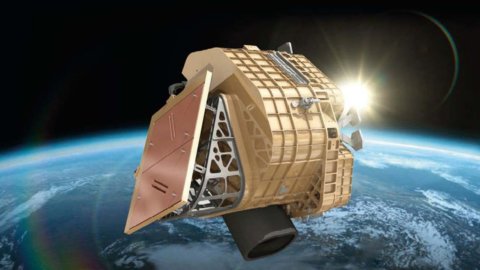In the night between 8 and 9 March 2019, Prisma (HyperSpectral Precursor of the Application Mission), the mission of the Italian Space Agency, will be launched from the European space base of Kourou in French Guiana
From its orbit, at about 620 kilometers above sea level, Prisma will look at the Earth on a global scale and will be able to do so with different eyes thanks to the innovative electro-optical instrumentation. The Italian satellite will be able to observe the earth with the most powerful operational hyperspectral instrument in the world, able to work in numerous, narrow and contiguous bands arranged from the visible to the near infrared (VNIR, Visible and Near InfraRed) and up to the infrared short (SWIR, Short Wave InfraRed).
The Prisma satellite is an ASI project, an all-Italian pride that highlights our country's ability to provide a turnkey space system, from design to construction, from launch to ground data management.
Prisma was in fact created by a RTI, Temporary Grouping of Companies, led by OHB Italia, responsible for the mission and management of the three main segments (ground, flight and launch), and Leonardo, who created the electro-optical instrumentation. It should also be underlined that the launch will take place with the VEGA vector produced by AVIO, an ESA launcher but mainly Italian in concept and construction. The mission control center was created by Telespazio while data acquisition and processing will take place at the Matera Space Centre.
Thanks to this mission it will be possible to observe natural resources from space and study the main environmental processes (eg interactions between the atmosphere, biosphere and hydrosphere; observation of changes in the environment and climate at a global level; effects of human activities on ecosystems). In the application field, Prisma will be able to provide information to support prevention works with respect to natural (such as hydrogeological) and anthropic (including soil pollution) risks, the monitoring of cultural heritage, actions to assist humanitarian crises, agricultural activities and exploitation of mineral resources.
As Leonardo explains in a note: "Unlike the currently operational satellite optical passive sensors, which record the solar radiation reflected by our planet in a limited number of spectral bands - typically a maximum of ten - the instrumentation on board the Prisma satellite is in fact capable of acquiring 240 (239 spectral bands plus the panchromatic channel); this will allow to refine the knowledge concerning natural resources and the main environmental processes in progress, such as the phenomena related to climate change. In fact, hyperspectral technology allows us to see more than the human eye and to recognize not only the shapes of objects but also which chemical elements they contain.”




